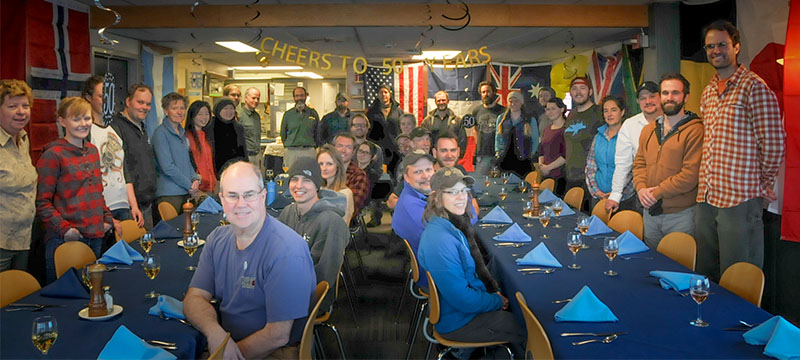
Tuesday was a very special day here at Palmer Station and we threw a party – a birthday party. Tuesday, 20 March 2018, was the 50th anniversary of the dedication of the current station.
Last year, on 18 March 2017, Maggie and I both had planned to make an announcement at the regular Saturday afternoon station meeting that the following Monday was the 49th anniversary of the dedication of the Bio Lab building, the first of the two main buildings at the present Palmer Station to be completed. (Maggie raised her hand first and beat me to making the announcement. For the last few years she had written ”Happy Xth Birthday Palmer” on the station message board anyway.)
After that meeting, I talked to Bob Farrell, the support contractor’s Palmer Area Manager who was also serving as on-site Station Manager then, about contacting the NSF (National Science Foundation) to get plans underway for a 50th Anniversary celebration this year. Bob was enthusiastic about the idea as were our colleagues in the Office of Polar Programs (OPP) at NSF.
The original, much smaller, Palmer Station was completed in 1965 a bit over a mile away from the current station and was only intended as a short-term facility while the current station was being planned and constructed. The site was chosen because there was a small existing hut built previously by the British Antarctic Survey which the British allowed us to utilize as a laboratory.
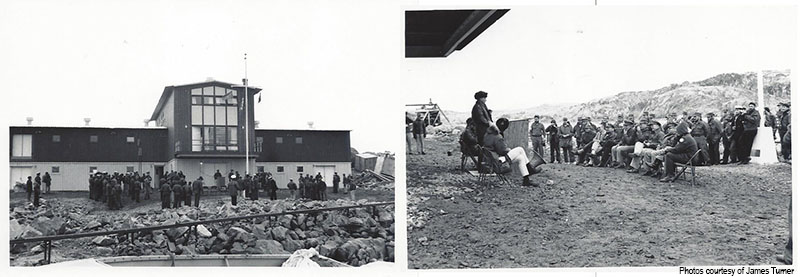
In early January 1967, a group of “Seabees” from US Naval Construction battalion Unit 201 arrived at Palmer to begin construction of the new station. Over the next several months they leveled ground for the Bio Lab building and fuel tanks, built the tanks and station pier, and built the Bio Lab foundation and first-floor flooring.
The Seabees returned in the 1967-68 austral summer to finish the building. On the morning of 20 March 1968, Rear Admiral J.L. Abbot, Jr., Commander of the US Naval Support Force Antarctica and Philip Smith from NSF arrived on the Coast Guard icebreaker Southwind. At 5:30 PM, they led the dedication ceremony at the station flagpole as shown in the black-and-white photographs above. Part of the ceremony was raising the US flag over the station for the first time on the flagpole you can see in the photographs.
That same flagpole is in that same spot today, although there is a boathouse on the water side of it now. We had planned to start our anniversary celebration with speeches at 5:30 PM in that same area and then raise the US flag just as had been done exactly 50 years prior. Unfortunately, the weather on Tuesday turned out to be nasty. The winds were in the 20 to 30 knot range sustained with even stronger gusts, it was intermittently snowing or sleeting, and the wind was out of the west so that neither the main building nor the boathouse provided any protection.
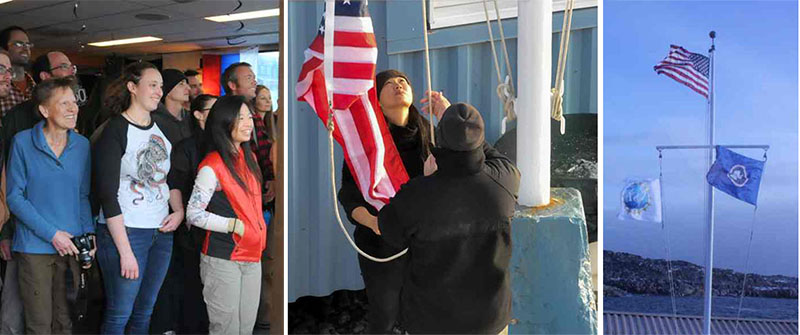
Because of the weather, we decided to move most of the ceremony inside. But Keri Nelson, our Administrative Coordinator, and Cargoperson Aldo Ruiz, a 23-year veteran of the US Air Force, still raised the US flag followed by the NSF and USAP (US Antarctic Program) flags on the yardarms. The rest of us watched from the comfort of the galley which has windows directly overlooking the flagpole.
The galley tables were arranged in a U-shape with the open end by the windows where we watched the flag raising. Hung from the surrounding walls were flags of the 12 nations that were the original signatories of the Antarctic Treaty which set Antarctica aside for scientific and other peaceful activities.
As Station Science Leader (SSL), part of my role is to represent NSF when no NSF employees are here. Prior to the flag raising, I read comments from Dr. Kelly Falkner, Director of OPP at NSF. She wrote about the importance of Palmer Station to US and global research, and ended with: “Congratulations to you all on the 50th anniversary of world-class research at Palmer. And here’s to 50 more.”
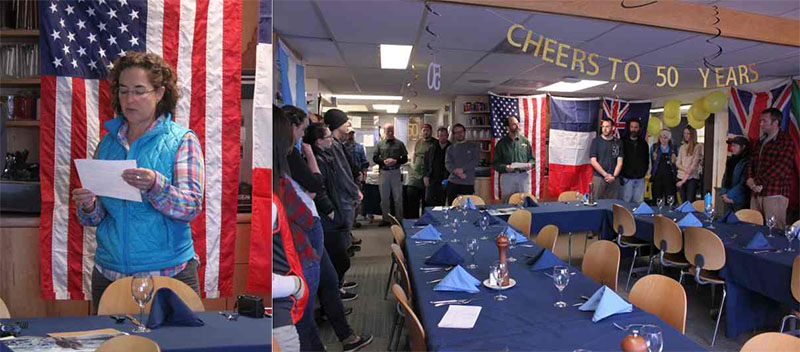
Rebecca Shoop, our current Station Manager, then talked about what a special place Palmer is in many ways and how much people who work here connect with it and want to come back. Her remarks ended: “Clearly, an anniversary is a good moment to recommit to what should never change. We hope that this place will continue to operate under the goals of the Antarctic Treaty, that it will always be a place for science where the awe of the natural environment and the strength and charm of the community will continue to be a place where people long to be. Happy 50th Palmer Station!”
Finally, before the flag raising, I made a few remarks in my capacity as SSL that were very much in line with Dr. Falkner’s and Rebecca’s. I noted all the different kinds of science that have been done here and described a Web search I had done which revealed that on the order of 100 papers per year have come out of the research here since the station was founded.
I ended my remarks with: “That is a phenomenal record of productivity for such a small research outpost. While it certainly speaks to the hard work of the scientists laboring in the labs and on the water, their efforts alone cannot explain it. The exceptional productivity that we in the science groups can have here at Palmer is only possible because we are part of a much greater community comprised of everyone on station.
“All of us should be proud of what we and our predecessors have accomplished here. I am certain that we will be just as proud of what we and our successors will accomplish in the next 50 years as part of this wondrous, and very special, community for science.”
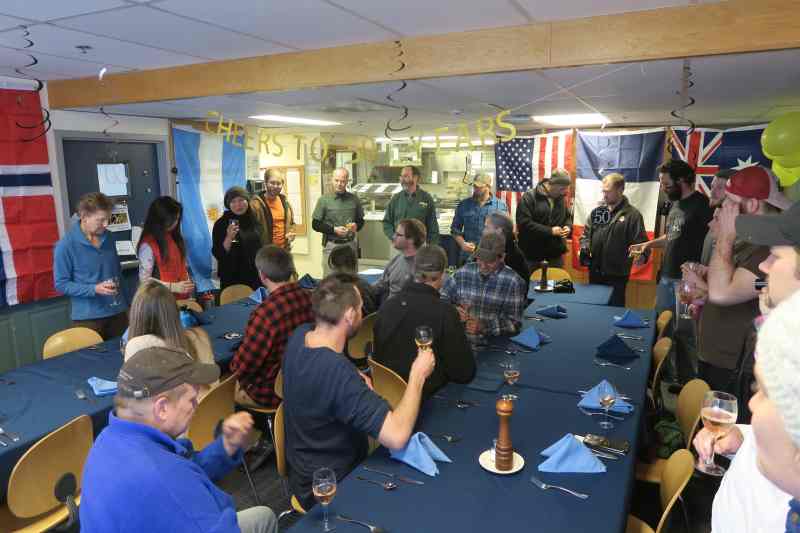
After the flag raising, Keri Nelson led us in a champagne (or sparkling orange juice) toast to Palmer Station, to the US and international commitment to science in Antarctica, and particularly to the spirit of cooperation between nations that is a hallmark of Antarctic science. It is fitting that she did it in front of the flag of Argentina, one of the 12 original signatories.
A couple weeks ago we were visited by the Argentinian icebreaker Almirante Irízar. Part of their visit was to thank us for US help in a recent search and rescue operation and for US willingness to help with a recent medical evacuation from one of their research stations (our help on that turned out not to be needed). Shortly thereafter, the Almirante Irízar in turn helped the USAP in using their helicopters to extract one of our geology field teams from an island when ice prevented our own ship from getting to them at the planned time (they had plenty of food but it was a great help to us to get them out without a prolonged delay).
During their visit, our guests from the Almirante Irízar gave us several bottles of Argentine champagne and Malbec wine. So it was very fitting that Keri’s toast to international cooperation in Antarctica was made with that Argentinean champagne. And the Malbec was a great accompaniment to the roast pork and duck we had as part of the festive dinner that followed.
A most special part of the event came between the toast and dinner. Through the wonders of the internet, I had located Jim Turner in South Carolina. Jim was one of the original Seabees who had been here building the station in both the 1966-67 and 1967-68 austral summers and who had been here for the original station dedication. The black-and-white photos of that ceremony I have above were provided by Jim.
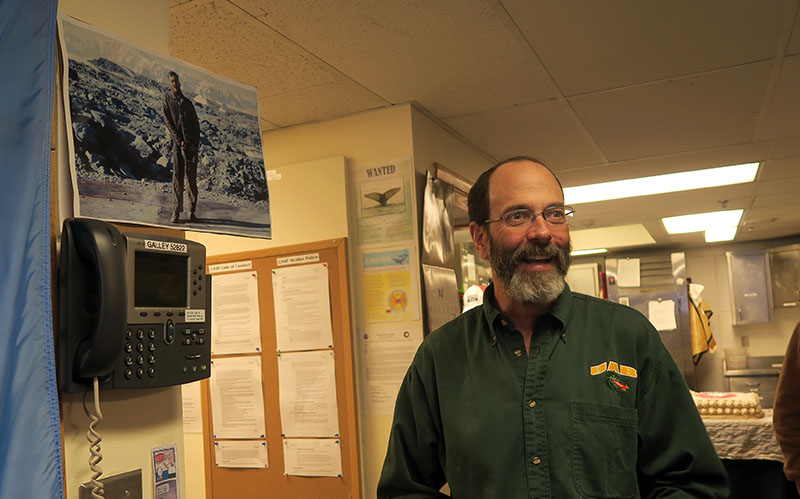
Jim also sent me a photo of himself standing on the foundation of one of the fuel tanks as it was being built, with a backdrop very familiar to everyone who has worked here since. There is a speaker phone in the galley. We put that photo of Jim above it and phoned him to say thanks to him, and through him to all his Navy colleagues, for constructing this wonderful place.
Jim spent a couple minutes telling us a tiny bit about how challenging parts of that construction had been. There was no more fitting ending to the formal part of our anniversary commemoration than that human connection back to the beginning of the 50 years of this very special station’s history.
[UAB in Antarctica thanks Zee Evans, Keri Nelson, and Jim Turner for some of the photos in this post.]